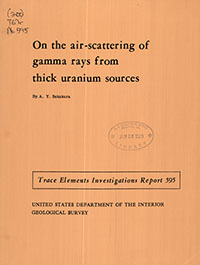On the air-scattering of gamma rays from thick uranium sources
Links
- Document: Report
- Download citation as: RIS | Dublin Core
Abstract
Semiquantative interpretation of data from airborne radioactivity surveying requires detailed knowledge of air-scattered gamma-ray intensity at considerable air distances from natural, thick uranium sources. Based on the concept of an elementary source of infinite thickness rather than on the classical point source, semi-empirical expressions, are developed for measured gamma-radiation intensities from . the two extreme types of natural, thick uranium sources, the elementary (point) and t-he broad (semi-infinite) source. These expressions agree both with extensive experimental data and with the form and structure of theory.
Theoretical computations based on published solutions of the Boltzmann equation for ga.m.ma-ray transport in one medium agree closely with experimental measurements. The calculated value for primary, scattered, and total intensities from thick uranium sources show that at considerable air distances the scattered intensities are more than half of the total intensities for energies above 0.4 Mev and become considerably more than half as the lower limit of detector energy response is decreased below 0.4 Mev.
| Publication type | Report |
|---|---|
| Publication Subtype | USGS Numbered Series |
| Title | On the air-scattering of gamma rays from thick uranium sources |
| Series title | Trace Elements Investigations |
| Series number | 595 |
| DOI | 10.3133/tei595 |
| Year Published | 1955 |
| Language | English |
| Publisher | U.S. Geological Survey |
| Description | 99 p. |


